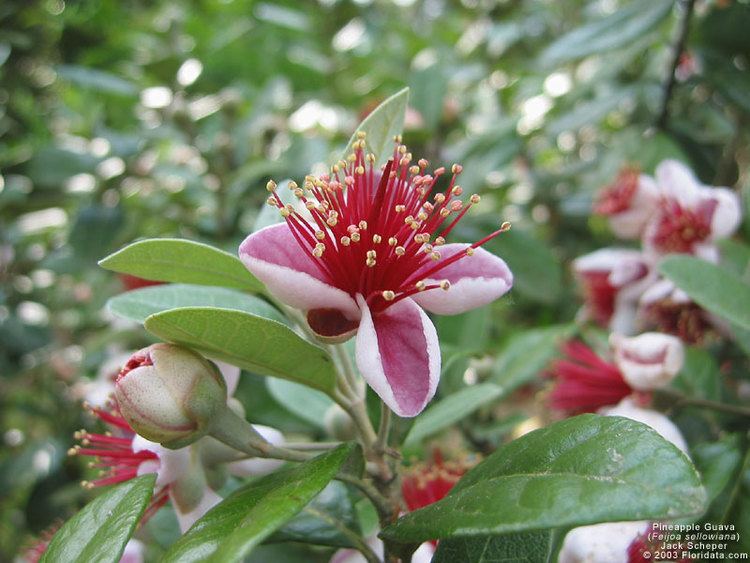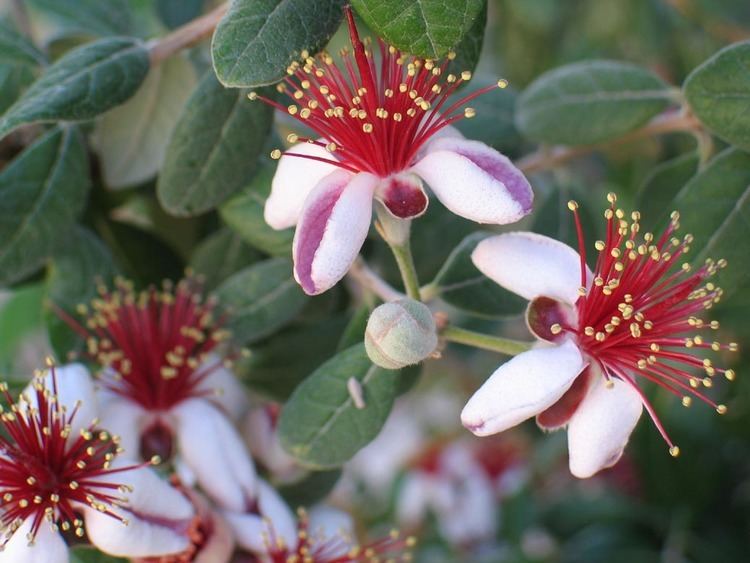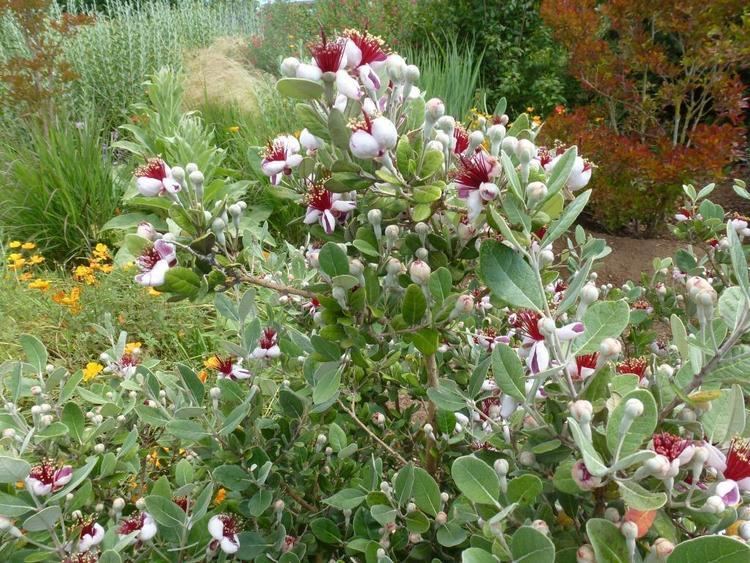Kingdom Plantae Family Myrtaceae Species A. sellowiana | Order Myrtales Genus Acca | |
 | ||
Similar Tamarillo, Passion fruit, Kumquat, Water, Common guava | ||
Harvesting ripe pineapple guava aka feijoa acca sellowiana
Acca sellowiana, a species of flowering plant in the myrtle family, Myrtaceae, is native to the highlands of southern Brazil, eastern Paraguay, Uruguay, northern Argentina, and Colombia. It is widely cultivated as a garden plant and fruiting tree. Common names include feijoa (/feɪˈʒoʊ.ə/, /feɪˈdʒoʊ.ə/, or /feɪˈhoʊ.ə/), pineapple guava and guavasteen, although it is not a true guava. It is an evergreen, perennial shrub or small tree, 1–7 metres (3.3–23.0 ft) in height, widely cultivated as an ornamental tree and for its fruit.
Contents
- Harvesting ripe pineapple guava aka feijoa acca sellowiana
- Acca sellowiana pineapple guava
- Etymology
- Fruit
- Growing conditions
- Seasonality
- Nutrition
- Food uses
- Sale and shipping
- Cultivation
- Varieties
- References

Acca sellowiana pineapple guava
Etymology

Feijoa sellowiana Berg is from the genus which the German botanist, Ernst Berger, named after João da Silva Feijó, a Portuguese naturalist, and the specific name honors Friedrich Sellow, a German who first collected specimens of feijoa in southern Brazil. It has been nicknamed "pineapple guava", "Brazilian guava", "fig guava" or "guavasteen" among different countries.
Fruit

The fruit, maturing in autumn, is green, ellipsoid, and about the size of a chicken egg. It has a sweet, aromatic flavor, which tastes like pineapple, apple and mint. The flesh is juicy and is divided into a clear, gelatinous seed pulp and a firmer, slightly granular, opaque flesh nearer the skin. The fruit falls to the ground when ripe and at its fullest flavor, but it may be picked from the tree prior to falling to prevent bruising.

The fruit pulp resembles the closely related guava, having a gritty texture. The feijoa pulp is used in some natural cosmetic products as an exfoliant. Feijoa fruit has a distinctive, potent smell that resembles that of a fine perfume. The aroma is due to the ester methyl benzoate and related compounds that exist in the fruit.
Growing conditions
It is a warm-temperate to subtropical plant that also will grow in the tropics, but requires at least 50 hours of winter chilling to fruit, and is frost-tolerant. When grown from seed, feijoas are noted for slow growth during their first year or two, and young plants, though cold tolerant, can be sensitive to high wind.
In the Northern Hemisphere, this species has been cultivated as far north as western Scotland, but under such conditions it does not fruit every year, as winter temperatures below approximately −9 °C (16 °F) kill the flower buds. Summer temperatures above 90 °F (32 °C) may also have an adverse effect upon fruit set. Feijoas are somewhat tolerant of drought and salt in soils, though fruit production can be adversely affected. Tolerant to partial shade, regular watering is essential while fruit is maturing.
Seasonality
Quantities of the fruit are grown in New Zealand, where it is a popular garden tree and the fruit commonly is available in season; the season runs from March to June. Feijoas are occasionally to be found as landscape plants in the far Southern United States, in regions from Texas to Florida, and southern California, though fruit set can be unreliable in those locations. They are also grown in parts of northern California for their fruit. Fruits are an extremely rare sight away from cultivation areas, and when they can be found, they are often expensive because they are scarce and in high demand even in places where the fruit is not well known.
Nutrition
100 grams of raw feijoa provides 55 Calories and is 13% carbohydrates, 8% sugars, and 1% each of fat and protein. The raw fruit is an excellent source of vitamin C, providing 40% of the Daily Value, but supplies no other nutrients in significant amount.
Food uses
Although the skin is edible, the fruit usually is eaten by cutting it in half, then scooping out the pulp with a spoon. The fruit has a juicy, sweet seed pulp and slightly gritty flesh nearer the skin. Feijoa may be torn or bitten in half and the contents squeezed out and consumed. An alternative method is to bite the end off and then tear the fruit in half length ways, exposing a larger surface with less curvature and using one's teeth to scrape the pulp out closer to the skin.
A feijoa may be used as an interesting addition to a fruit smoothie, and may be used to make wine or cider and feijoa-infused vodka. The flavour is aromatic, strong and complex, inviting comparison with guava, strawberry, pineapple, and often containing a faint wintergreen-like aftertaste. It also is possible to buy feijoa yogurt, fruit drinks, jam, ice cream, and such in New Zealand. It also may be cooked and used in dishes where one would use stewed fruit. It is a popular ingredient in chutney. The very strong, complex flavour can make using feijoas, in combination with other fruits or vegetables, a creative and complex undertaking.
Fruit maturity is not always apparent visually, as the fruits remain the same shade of green until they are overripe or rotting. One usually may sense ripeness, however, by giving the fruit a soft squeeze; a ripe feijoa yields to pressure somewhat like a just-ripe banana. Generally, the fruit is at its optimum ripeness the day it drops from the tree. While still hanging, it may well prove bitter; once fallen, however, the fruit very quickly becomes overripe, so daily collection of fallen fruit is advisable during the season.
When the fruit are immature, the seed pulp is white and opaque. It becomes clear and gelatinous when ripe. Fruits are at their optimum maturity when the seed pulp has turned into a clear jelly with no hint of browning. Once the seed pulp and surrounding flesh start to brown, the fruit is overripe, but still may be eaten, or used to make a delicious juice, jam, or compote.
The flower petals are edible, with a slightly sweet flavor with hints of cinnamon. The most common use is as an addition to salads. They regularly are consumed by birds.
Sale and shipping
Ripe fruit is prone to bruising; difficulty maintaining the fruit in good condition for any length of time, along with the short period of optimum ripeness and full flavor, probably explains why feijoas frequently are not exported, and where grown commercially, are typically sold close to the source of the crop. However, intercontinental shipping of feijoa by sea or air has been successful.
Because of the relatively short shelf-life, store keepers need to be careful to replace older fruit regularly to ensure high quality. In some countries, they also may be purchased at roadside stalls, often at a lower price.
Feijoas may be cool-stored for approximately a month and still have a few days of shelf-life at optimum eating maturity. They also may be frozen for up to one year without a loss in quality.
Cultivation
Some grafted cultivars of feijoa are self-fertile. Most are not, and require a pollinator. Seedlings may or may not be of usable quality, and may or may not be self-fertile. Feijoas will mature into a sprawly shrub, but can be kept successfully as a large container plant, though accommodations will need to be made for the width of the plants, and the need to encourage new growth for fruit production. They can succeed in greenhouses in temperate parts of the United States, and have been grown in-ground as fruiting trees on the United States east coast in coastal Georgia and South Carolina as well as in California. Other regions of the United States: the Pacific Northwest, the southernmost Appalachian Mountains, and the immediate coastal region from North Carolina to Delaware all would warrant further investigation.
In the South Caucasus, feijoa has been cultivated in the southern coastal region of Azerbaijan since 1928; cultivation in neighboring Georgia has gradually increased to about 988 hectares in 1986.
In New Zealand, the pollinators of this plant are bees, bumblebees, and medium-sized birds. The silvereye is a pollinator in the cooler parts of the South Island; the blackbird and the Indian myna, which feeds on the sweet, fleshy flower petals, are pollinators further north.
In some areas where the species has been introduced, however, the trees have been unproductive due to lack of pollinators. The shrub has very few insect pests, although guava moth is a problem in northern New Zealand.
Varieties
Numerous cultivars of feijoa have been developed.
